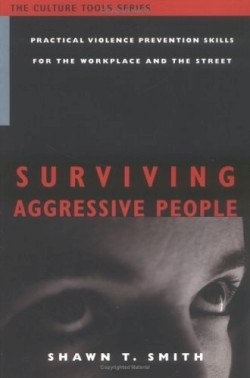Surviving Aggressive People
Practical Violence Prevention Skills for the Workplace and the Street
Who would ever want to boost the self-respect of an overly aggressive person? The author, for one. Why? Because, says Smith, an expert on psychology and violence prevention, the probability of violence escalates when shame, guilt, or humiliation undermine an aggressive person’s ego. He advocates—and teaches—a stance that lessens that probability without appeasing bad behavior. Like Gandhi, he trains “warriors” to disarm their opponents with respect rather than conventional force, using soft rather than hard approaches to violence prevention. His practical psychology rings true; Smith has accumulated years of experience confronting and defusing violence in bars, streets, and rehabilitation programs. He is also a student of martial arts.
The book has four parts: The Ground Rules; Desperate Aggression (to which Smith provides responses of listening, empathizing, and providing options); Expert Aggression (which includes terrorism); and The Path to Peace. To oversimplify somewhat, the difference between desperate and expert aggressors is the difference between people who feel like victims and people who prey upon those who act like victims. Smith offers ideas and techniques to deal with both types. This book “is essentially about two life-saving ideas. First is the ability to recognize impending hostility. Second is the willingness to act early…”
Smith uses apt anecdotes and a narrative style that keeps the reader eager, awake, and open to turning old saws into new tools of conflict resolution, e.g., how to maintain boundaries with gentle, confident strength, and how to set limits while offering reasonable options. Smith says that his method builds on things that reside unused in corners of the mind. “Only when we haven’t exercised our knowledge of human behavior do attackers seem to strike ‘out of the blue.’ The truth is, violence is almost always preceded by warning signs.” A moment’s thought is enough to realize that “Calm down!” and other scolding and belittling are bad habits that turn annoyances into real problems. A few hours of training may make a huge difference, providing sensible alternatives that turn dangerous situations into peaceful outcomes. Smith provides scenarios that groups (as few as three) can use for role-play exercise.
Smith has read widely and cites excellent resources. Missing, unfortunately, is any reference to Gandhian psychology or the excellent books on Verbal Self-Defense by linguist Suzette Haden Elgin. Nonetheless, this book will earn a place with the all-too-few great practical writings on preventing and managing aggression in many contexts.
Reviewed by
E. James Lieberman
Disclosure: This article is not an endorsement, but a review. The publisher of this book provided free copies of the book to have their book reviewed by a professional reviewer. No fee was paid by the publisher for this review. Foreword Reviews only recommends books that we love. Foreword Magazine, Inc. is disclosing this in accordance with the Federal Trade Commission’s 16 CFR, Part 255.

